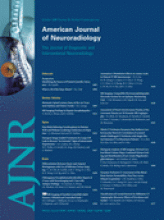Research ArticleINTERVENTIONAL
Wall Shear Stress on Ruptured and Unruptured Intracranial Aneurysms at the Internal Carotid Artery
L.-D. Jou, D.H. Lee, H. Morsi and M.E. Mawad
American Journal of Neuroradiology October 2008, 29 (9) 1761-1767; DOI: https://doi.org/10.3174/ajnr.A1180
L.-D. Jou
D.H. Lee
H. Morsi

Submit a Response to This Article
Jump to comment:
No eLetters have been published for this article.
In this issue
Advertisement
L.-D. Jou, D.H. Lee, H. Morsi, M.E. Mawad
Wall Shear Stress on Ruptured and Unruptured Intracranial Aneurysms at the Internal Carotid Artery
American Journal of Neuroradiology Oct 2008, 29 (9) 1761-1767; DOI: 10.3174/ajnr.A1180
Jump to section
Related Articles
- No related articles found.
Cited By...
- Hemodynamic differences between Pipeline and coil-adjunctive intracranial stents
- Towards the Clinical utility of CFD for assessment of intracranial aneurysm rupture - a systematic review and novel parameter-ranking tool
- Influence of Carotid Siphon Anatomy on Brain Aneurysm Presentation
- Monocyte Chemotactic Protein-1-Interleukin-6-Osteopontin Pathway of Intra-Aneurysmal Tissue Healing
- Geometric Parameter Analysis of Ruptured and Unruptured Aneurysms in Patients with Symmetric Bilateral Intracranial Aneurysms: A Multicenter CT Angiography Study
- Clinical, morphological, and hemodynamic independent characteristic factors for rupture of posterior communicating artery aneurysms
- Hemodynamic-morphological discriminant models for intracranial aneurysm rupture remain stable with increasing sample size
- Guidelines for the Management of Patients With Unruptured Intracranial Aneurysms: A Guideline for Healthcare Professionals From the American Heart Association/American Stroke Association
- Rupture Resemblance Score (RRS): toward risk stratification of unruptured intracranial aneurysms using hemodynamic-morphological discriminants
- Morphologic and hemodynamic analysis of paraclinoid aneurysms: ruptured versus unruptured
- CFD: Computational Fluid Dynamics or Confounding Factor Dissemination? The Role of Hemodynamics in Intracranial Aneurysm Rupture Risk Assessment
- Toward Improving Fidelity of Computational Fluid Dynamics Simulations: Boundary Conditions Matter
- High WSS or Low WSS? Complex Interactions of Hemodynamics with Intracranial Aneurysm Initiation, Growth, and Rupture: Toward a Unifying Hypothesis
- Wall shear stress association with rupture status in volume matched sidewall aneurysms
- Rupture-Associated Changes of Cerebral Aneurysm Geometry: High-Resolution 3D Imaging before and after Rupture
- Role of Fluid Dynamics and Inflammation in Intracranial Aneurysm Formation
- Analysis of Morphologic and Hemodynamic Parameters for Unruptured Posterior Communicating Artery Aneurysms with Oculomotor Nerve Palsy
- Effect of Bifurcation Angle Configuration and Ratio of Daughter Diameters on Hemodynamics of Bifurcation Aneurysms
- Newtonian viscosity model could overestimate wall shear stress in intracranial aneurysm domes and underestimate rupture risk
- Hemodynamic Differences Between Unruptured and Ruptured Intracranial Aneurysms During Observation
- Hemodynamics of Cerebral Aneurysm Initiation: The Role of Wall Shear Stress and Spatial Wall Shear Stress Gradient
- Patient-Specific Computational Hemodynamics of Intracranial Aneurysms from 3D Rotational Angiography and CT Angiography: An In Vivo Reproducibility Study
- Hemodynamics and Anatomy of Elastase-Induced Rabbit Aneurysm Models: Similarity to Human Cerebral Aneurysms?
- Hemodynamic-Morphologic Discriminants for Intracranial Aneurysm Rupture
- An objective approach to digital removal of saccular aneurysms: technique and applications
This article has been cited by the following articles in journals that are participating in Crossref Cited-by Linking.
- B. Gregory Thompson, Robert D. Brown, Sepideh Amin-Hanjani, Joseph P. Broderick, Kevin M. Cockroft, E. Sander Connolly, Gary R. Duckwiler, Catherine C. Harris, Virginia J. Howard, S. Claiborne (Clay) Johnston, Philip M. Meyers, Andrew Molyneux, Christopher S. Ogilvy, Andrew J. Ringer, James TornerStroke 2015 46 8
- H. Meng, V.M. Tutino, J. Xiang, A. SiddiquiAmerican Journal of Neuroradiology 2014 35 7
- Jianping Xiang, Sabareesh K. Natarajan, Markus Tremmel, Ding Ma, J Mocco, L. Nelson Hopkins, Adnan H. Siddiqui, Elad I. Levy, Hui MengStroke 2011 42 1
- Hiroyuki Takao, Yuichi Murayama, Shinobu Otsuka, Yi Qian, Ashraf Mohamed, Shunsuke Masuda, Makoto Yamamoto, Toshiaki AbeStroke 2012 43 5
- V. L. Rayz, L. Boussel, L. Ge, J. R. Leach, A. J. Martin, M. T. Lawton, C. McCulloch, D. SalonerAnnals of Biomedical Engineering 2010 38 10
- Z. Kulcsár, Á. Ugron, M. Marosfői, Z. Berentei, G. Paál, I. SzikoraAmerican Journal of Neuroradiology 2011 32 3
- J. Xiang, V.M. Tutino, K.V. Snyder, H. MengAmerican Journal of Neuroradiology 2014 35 10
- Martin Spiegel, Thomas Redel, Y. Jonathan Zhang, Tobias Struffert, Joachim Hornegger, Robert G. Grossman, Arnd Doerfler, Christof KarmonikComputer Methods in Biomechanics and Biomedical Engineering 2011 14 1
- Alexis S. Turjman, Francis Turjman, Elazer R. EdelmanCirculation 2014 129 3
- Koji Hosaka, Brian L. HohTranslational Stroke Research 2014 5 2
More in this TOC Section
Similar Articles
Advertisement











